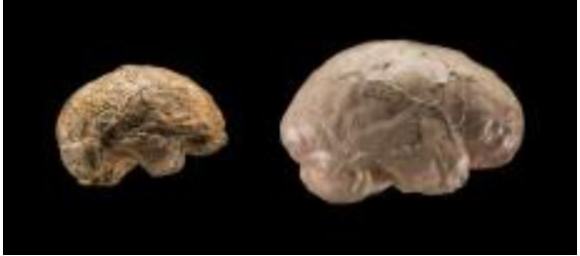“The sense of doing good, the satisfaction of being right, the joy of looking favorably upon oneself, dear sir, are powerful levers for keeping us upright and making us progress. On the other hand, if men are deprived of that feeling, they are changed into rabid dogs.” – Albert Camus, “A Life Worth Living”
Artificial intelligence (AI ) is intelligence demonstrated by machines, in contrast to the human intelligence displayed by human beings.
The field of AI was founded on the claim that human intelligence “can be so precisely described that a machine can be made to simulate it”. However the specification of human intelligence has proved to be a bit more elusive than originally thought and AI researchers have much work to be done.

Astronomer and astrophysicist Carl Sagan wrote, “My fundamental premise about the brain is that its workings—what we sometimes call “mind”—are a consequence of its anatomy and physiology, and nothing more… The anatomy and physiology of which Dr. Sagan wrote has been described by David Linden, professor of neuroscience at Johns Hopkins University, as composed of three major parts:”
-
- Human Brain – (The “neocortex” responsible for the development of abstract thought, imagination, consciousness and human language,.
-
- Mouse Brain – (The limbic brain) records memories of behaviors that produced agreeable and disagreeable experiences. It’s responsible for what are called emotions in human beings.
- Reptilian Brain – (Lizard Brain) the oldest of the three parts, it controls the body’s vital functions such as heart rate, breathing, body temperature and balance. It includes the main structures found in a reptile’s brain: the brainstem and the cerebellum.Sharon Begley that summarized his conclusions:
Sharon Begley that summarized Dr. Linden’s conclusions this way:
“To [David Linden], the brain is a ‘cobbled-together mess.’ Impressive in function, sure. But in its design the brain is ‘quirky, inefficient and bizarre … a weird agglomeration of ad hoc solutions that have accumulated throughout millions of years of evolutionary history.’ … More than another salvo in the battle over whether biological structures are the products of supernatural design or biological evolution … research on our brain’s primitive foundation is cracking such puzzles as why we cannot tickle ourselves, why we are driven to spin narratives even in our dreams, and why reptilian traits persist in our gray matter.”
Furthermore, the three parts of the brain do not operate independently. They have established numerous interconnections through which they exchange information and influence one another. The neural pathways from the limbic system to the cortex, for example, are especially well developed. It’s these neural pathways through which information is transferred that are proving most difficult for AI researchers to emulate.
According to Dr. Linden we can find all of the very same parts he describes in a human brain ” but Linden says, there’s a difference — the brain of an adult human is about three times the size of a gorilla brain.
Endocasts of Homo erectus ( 1.8 million years ago) brain, to the left and Homo sapiens (300,000 years ago) brain, to the right in picture below, illustrates increase in brain size.

- From 6–2 million years ago – ( Brain and body size increase) During this time period, early humans began to walk upright and make simple tools. Brain size increased, but only slightly.
- From 2 million–800,000 years ago – During this time period early humans spread around the globe, encountering many new environments on different continents. These challenges, along with an increase in body size, led to an increase in brain size.
- From 800,000–200,000 years ago ( Brain size increases rapidly) Human brain size evolved most rapidly during a time of dramatic climate change. Larger, more complex brains enabled early humans of this time period to interact with each other and with their surroundings in new and different ways. As the environment became more unpredictable, bigger brains helped our ancestors survive.
AI developers may not want to acknowledge it but much of human intelligence is serendipitous. It’s not organized or planned-out like AI algorithms. While thoughtful people can create the contours of an intelligent thought they’re most likely to encounter an “a-ha” moment when their thinking leaps to what they see as a solution or revelation. These “a-ha” moments come about largely because of the interconnections among the three parts of the human brain. As Dr. Damasio has written “at the point of decision, emotions are very important for choosing. In fact even with what we believe are logical decisions, the very point of choice is arguably always based on emotion.”
One of the most widely applied AI algorithms is the Artificial Neural Network (ANN) or connectionist system. ANNs are computing systems inspired by the biological neural networks that constitute animal brains. ANN’s “learn” through a mechanical form of evolution. They consider examples, generally without being programmed with any task-specific rules. Instead of evolving ANNs are “trained” to make reliable comparisons between items in a database and an observation made by one or more sensors integrated with a computer. To achieve the goal of AI researchers, and build “a machine that can be made to simulate the human brain” AI researchers may need to encode “a-ha” moments.
ANNs don’t have “a-ha” moments. They depend on rigor and coding discipline to arrive at a “right answer” ANNs have no “satisfaction of being right”. They simply stop when they’ve determined they are statistically more likely to be right than wrong. Coding “a-ha” moments, that “feel they are right”, may be the next big challenge for AI researchers. Until then AI researchers may have built nothing more than what Camus called a “rabid dog”.
________________________________________________________________________________________
Notes:
- Albert Camus, “A Life Worth Living”, ( http://filozofia.uni-miskolc.hu/wp-content/uploads/2011/11/Robert-Zaretsky-A-Life-Worth-Living_-Albert-Camus-and-the-Quest-for-Meaning-Belknap-Press-2013.pdf)
- Carl Sagan “The Dragons of Eden”, Ballantine Books, New York, 1977
- http://thebrain.mcgill.ca/flash/d/d_05/d_05_cr/d_05_cr_her/d_05_cr_her.html
- The Human Brain: Marvel or Mess? | Newsweek Technology | Newsweek.com
- http://bigthink.com/experts-corner/decisions-are-emotional-not-logical-the-neuroscience-behind-decision-making